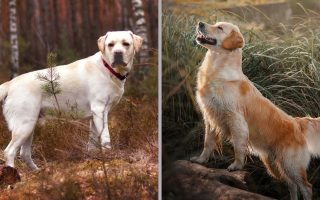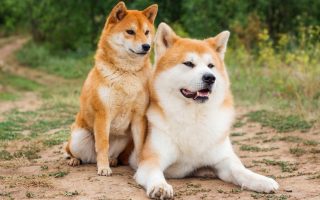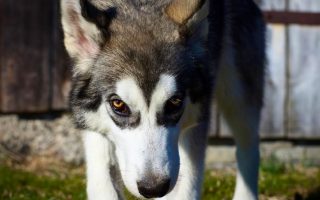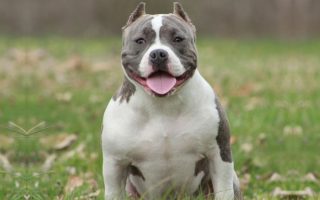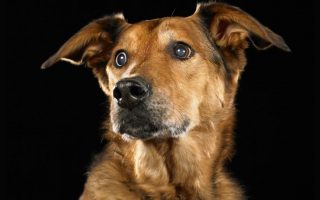Elegance, beauty, exoticness—these and more characterize the Afghan Hound.
Many people opt for this breed both for the aesthetic factor and other characters.
Moving on from hunting prey, they now sit comfortably in people’s homes where they show and receive love.
Making a decision to have a pet is a big one as there are many factors to consider.
You need a dog that can fit into your living environment, family, lifestyle, and level of activity.
It can get daunting, but information makes the process easier.
In this article, you will get to know all about Afghan Hound facts, dog breed j formation, and answer the question on every pet parent’s mind.
Is the Afghan Hound the right dog for me, or should I look for another? Read on!
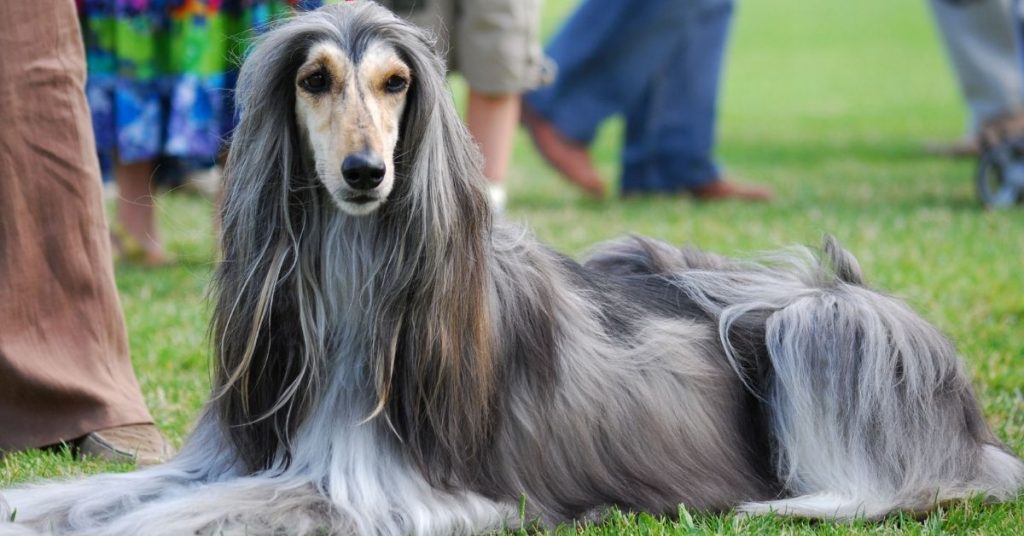
Key Afghan Hound Facts & Information
| Dog Breed Group | Hound |
| Height | 24 to 26 inches |
| Weight | 50 to 60 pounds |
| Coat | Silky |
| Color(s) | Black, cream, red |
| Life Expectancy | 10–12 years |
| Temperament | Aloof, dignified, happy, humourous |
| Origin | Afghanistan |
| Bred For | Hunting |
| Nickname(s) | Tāzī, Balkh Hound, Baluchi Hound, Barakzai Hound, Shalgar Hound, Kabul Hound, Galanday Hound |
| Recognized by the AKC | Yes |
Afghan Hound Characteristics
| Characteristics | Rating |
|---|---|
| Adaptability | 4/5 |
| Friendliness | 4/5 |
| Kid-Friendly | 4/5 |
| Pet-Friendly | 3/5 |
| General Health | 3/5 |
| Grooming Needs | 4/5 |
| Trainability | 1/5 |
| Intelligence | 4/5 |
| Playfulness | 4/5 |
| Exercise Needs | 4/5 |
| Energy Level | 4/5 |
| Tendency to Bark | 2/5 |
| Tendency to Drool | 1/5 |
| Tendency to Snore | 1/5 |
| Tendency to Dig | 1/5 |
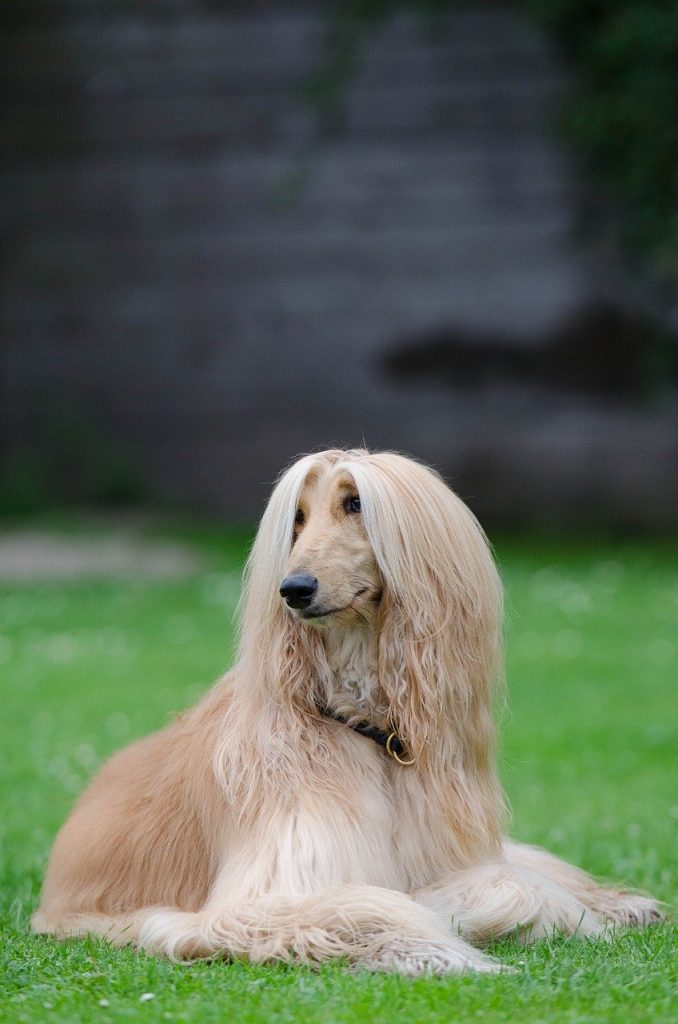
Little-known facts about the Afghan Hound
Fact #1: They’re old
Afghan hounds are one of the world’s oldest breeds, dated before the advent of the Christian religion.
Sources reveal they were a part of Alexander the Great’s army. According to historians, these guys are like a thousand years old.
Fortunately for us, they haven’t gone extinct since then. They still grace us with their elegance and beauty.
Fact #2: They are sighthounds
Sighthounds are dogs who hunt using their eyes rather than the nose, as other dogs do.
Once they sight prey, they go after it. This quality-made them good hunters but can be problematic to a modern owner who would have to restrain the dog from running off.
When you’re out with a sighthound, it is best to keep him on a leash.
Build a fence around your house as well. They’re good at escaping.
Fact #3: They are very fast
In addition to being sighthounds, their hunting skills stem from their speed. The Afghan moves as fast as 40mph, making them one of the fastest dog breeds.
Considering that racehorses go at a maximum of about 43mph, Afghans are fast.
This is another reason they have to be retained. Once they run off, moving after them is like pursuing a horse. Your chances are low.
Fact #4: They are sensitive to pain
Their grace, hunting skills, and dignity don’t mask the fact that they find it hard to endure pain. They’re likely to express their discomfort with whimpers, even for a little injury.
While grooming them, you have to be careful with clipping their nails or you may end up having to deal with some whining.
Fact #5: They have a long fur
The Afghan Hound is popular mainly because of its long, exotic fur.
When you own one, you’d have to get used to questions, gawks, and finger-pointing from strangers. If you’re one who loves attention, here’s a good chance.
The fur isn’t only for beauty though. The silky coat protects them from cold weather.
Afghan Hound Breed History & Origin
The Afghan Hound is an ancient breed hailing from Afghanistan. Back then, people called them Tazi.
With a millennium age to their profile, Afghan Hounds existed before modern breeds and are related to the Saluki.
They also share similarities with the Tasy, the Taigan, and the Batazkay.
Courtesy of English officials, the Afghan Hound came into the western world. They were introduced first in England, then in America through individuals like Zeppo Marx.
In 1926, the American Kennel Club recognized the Afghan Hound as a breed.
Afghan Hounds got popular in the late 20th century as they made fans out of admiring ladies. They’ve equally participated in a lot of competitions.
In Afghanistan, there were more than ten known Afghan Hound types. The modern Afghans owe their existence to two strains from Scotland and England.
The latter, named Ghazni, was the foundation of current American breeds.
Afghan Hounds no longer hunt. They are now much-desired household pets and companions to those who love them and can take care of their needs.
Afghan Hound Temperament & Intelligence
As puppies, Afghans love affection and would come looking for one from any available family member.
As they grow older, they tend to get withdrawn, independent and selective.
Your Afghan may even shy away from hugs and other forms of physical touch, things he liked as a puppy. You could say it’s their own way of showing maturity.
Nonetheless, Afghans are playful, mischievous, and compassionate when they want to be. Owners tend to see in them a paradox of personalities.
They could decide to be on their own today then pull a prank tomorrow.
As a pet parent, you’d find them entertaining when they come out of their shells and drop the indifference for some time.
Training and obedience don’t come naturally to an Afghan. As hunters, they used to think on their own.
They go far from their masters, corner a prey then send an alert. Hunters of old loved their independent spirit.
For the 21st century American, however, it is tasking to teach them how to behave.
You need a high dose of patience and consistency to get them to obey. Accidents are not unusual with this breed.
They are equally sensitive, especially to pain. They find it hard to endure even a simple injury.
Failure to know this and you may view your pet Afghan as dramatic when you hear whimpers over a little scratch.
This delicacy hidden in their free spirit means you have to be careful how you treat them and where they go.
Is an Afghan Hound a good family dog?
Afghans have a clownish, mischievous, and compassionate nature that makes them the first choice for many people as household pets.
It doesn’t hurt that they are beautiful, regal, and exotic. Having one in your house is a decoration of its own.
You have to consider their aloofness, though. If you want a dog to cuddle while you watch television or hug at random moments, the Afghan may not be a good choice.
They are generally unfriendly towards strangers and may ignore your visitors, potentially offending a dog lover who doesn’t understand the reclusive nature of this hound.
Are Afghan Hounds good with kids?
Afghans generally love children and get along with them just fine. However, the age of your kids matters.
Smaller kids tend to be loud, rougher, touchy-feely, and may not understand the Afghan’s need for personal space. This could be a problem to the sensitivity of the breed.
The ideal option is to have an Afghan in a home with children who are grown enough to understand how to relate with a dog and treat pets right.
Are Afghan Hounds good with other dogs and pets?
When properly trained, the Afghan Hound gets along well with other dogs and may not be aggressive towards them, at least not without cause.
For other pets, the story isn’t the same. Afghan Hounds are often considered a one-family pet and may not be so eager to share their space with a cat or hamster.
Even worse, they remain hunters at heart. That’s bad news for any pet around, including that of your neighbor.
Once they sight prey, they may go after it. You need to exercise caution in this aspect.
Male vs Female Afghan Hound
The male and female of any breed come with a set of strengths and weaknesses.
For most owners, gender is a matter of preference. If you want to get your dog neutered, then gender should not be an issue for you.
However, if you prefer an unneutered pet, you may want to get information on the gender differences to make your choice easier.
The male Afghan Hound is heavier and taller than the female counterpart.
While the latter weighs 50 pounds with a height of 25 inches, the former weighs 60 pounds and grows up to 27 inches.
The genitals are another noticeable difference. In general, the male genitals of any dog breed are visible, except in the case of the Afghan, it is shrouded in fur, saving possible embarrassment.
The male and female Afghan Hound are similar in their aloof temperament, though the male tends to be more independent.
Caring for an Afghan Hound
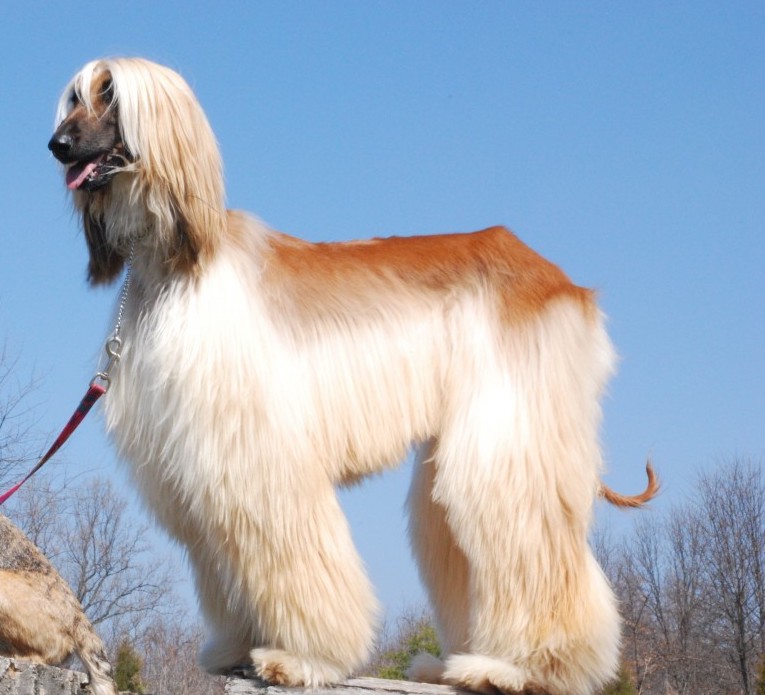
The Afghan Hound is an apartment dog who’s comfortable lying around indoors.
This is good for city dwellers, and they are not regular barkers, so no need to be concerned about neighbors.
However, they require exercise or they may seek other less constructive ways to be busy.
It is best to keep them in an enclosed area to stop them from bolting after a passing ‘prey’, especially if you live in the countryside.
They are fast so stopping them once they begin chasing is almost impossible. Prevention is better than apologizing to the old woman next door for her frightened cat.
Like a lot of dogs, training this breed may be daunting. They don’t do so well in obedience and may get you frustrated.
However, with patience, experience, and confidence, you will reap from your efforts.
Afghan Hound Food and Diet
What you feed your dog is essential to growth, overall health, and fitness. You have to get the right diets and proportions to avoid them either being underweight or overweight.
Afghan Hounds require a diet filled with beneficial nutrients. Do not simply scoop any food into his bowl. Their size and energy should be put into account when giving their meals.
This breed is okay with eating dry food in 2 to 2.5 cups, alongside some wet meals. Obese Afghans should eat less and exercise more.
Certain nutrients are good for your Afghan Hound and come highly recommended. Some of these nutrients are:
- Protein
- Fat
- Water
- Minerals
In contrast, avoid feeding them with:
- Onions and garlic
- Fried food
- Grapes
- Chocolates
Puppies and adult dogs do not have the same meal requirements, just like humans adults don’t eat like babies.
Thus, do not feed a puppy the way you would an adult. The Afghan Hound puppy needs more protein for growth in a proportion of one cup or 1½ a day.
The old Afghan Hound requires less than both puppies and young adults.
Their meal should be of smaller quantity than that of the younger Afghan.
Also Read: Bad Dog Foods to Avoid and Top Choices to Consider
Afghan Hound Exercise
Regular exercise is necessary for your dog, no matter what personality they have.
As humans exercise to keep fit, healthy, and look good, dogs need to work out their bodies.
For some dogs, lack of exercise can get them antsy. The result of this is havoc on your belongings. Even if your dog isn’t so energetic, they need exercise.
Some dogs have a high exercise need going up to 30 minutes or an hour. Others are content with simple movements after which they lie down for the rest of the day.
Before choosing a dog, you have to know whether you can cope with the exercise aspect. Of course, this depends on your lifestyle, personality, and work demands.
Afghan Hounds need rigorous exercise and can go for two hours. They are highly energetic and need to burn it out.
If you are not used to an active life, the Afghan may not be for you. The physical exercise consists of brisk walks, jogs, or just letting your Afghan run around the yard.
Supplement physical activities with some mental challenges too.
The puppies need a different exercise regime. They’re delicate and should not be allowed to run till they are six months old. After that, they can start long-distance running.
Older dogs don’t need as much exercise as younger ones, but you still have to keep them fit. This helps them control weight and avoid joint pains.
A dog is a man’s best friend, but only when they are trained. When they lack training, they become dangerous to everyone.
Even a gentle breed can turn wild without training. Thus, before you get a dog, you need to answer these few questions:
- Do you have the time to commit to your dog’s upbringing?
- Are you experienced enough?
- Can be breed be a domestic pet?
- How trainable is your favourite breed?
Also, know how to distinguish training from abuse. While you need confidence and strictness to teach your dog good manners, harsh treatments and punishments are not necessary and may do more harm than good.
Socialization is a must for any dog. Take them to different places and unwrap the world. Let them meet new people, get accustomed to unfamiliar sights, smell unknown scents and be friendly.
With the Afghan, patience is key. They are stubborn, agile, and are not eager to please, so you need to be tolerant yet firm with them.
Remember, they are very sensitive so rough methods of training may backfire on you.
Food motivations don’t work well with this breed, so you have to get other motivations to get them to obey.
They also get bored quickly, which is where diverse activities come in.
Meanwhile, until they are trained enough to go on their own, put them on a leash. Don’t forget their speed and high prey drive.
A new pet parent may find training an Afghan very tiring. However, with enough experience, consistency, gentleness, and confidence, you will succeed.
Afghan Hound Grooming Needs
Alongside other needs, your dog has to be neat and presentable. It says a lot of negative things about you if your dog comes out looking shabby, unruly, and dirty.
Afghans in particular stand out, so they have to be clean. Some dogs shed a lot, others don’t. Either way, grooming is essential.
If you have the experience and time, you may do it yourself. If not, consider hiring a groomer to get the job done.
The Afghan has a lot of furs and a high maintenance need. Grooming this breed takes time and a lot of effort. Here are some steps to achieve this:
- Brush and comb daily
- Give them regular bath
- Break up tangles to achieve smoothness
With the help of a breeder and practice, it becomes easier.
Their teeth and nails shouldn’t be neglected too. Make sure you brush their teeth at least twice a week and trim their nails before they get too long.
Grooming an Afghan should begin as a puppy to get them used to it. It takes time for any dog to allow someone to touch them enough to start grooming.
An early start goes a long way, and Afghans are certainly friendlier as pups. Positive reinforcements and rewards are necessary too.
If you detect signs of infection, illness, or injury while you groom, get your dog to the vet. Some telltale signs include:
- Sores
- Inflammation
- Red eyes
- Rashes
Meanwhile, because Afghans have long ears, they are vulnerable to ear infections. Clean their ears with a cotton ball and a recommended cleanser.
Do not stick any object into their ears. If there are red spots in the ear or your Afghan keeps scratching at it, there may be an infection.
Afghan Hound Health Conditions
Sadly, illness is a part of life, both for humans and furries. When you get a pet, it is important you check the medical history and be sure the animal is healthy. Also, keep in mind possible medical conditions.
The Afghan, when you take care of them, live long and stay healthy. Visits to the veterinarian are scarce with this breed. However, there are prone to illnesses like:
Allergies
This occurs when your dog reacts negatively to food, environment, or medicine. It manifests through sneezes, itching, loss of hair, a runny nose, etc.
Cataracts
This is an optical problem that leads to loss of sight in many dog breeds, including the Afghan. It occurs when the lens is obscured fully or partially, rendering it opaque.
Cancer
Just as dangerous in humans as it is in dogs, cancer is another medical condition that can threaten your Afghan. Symptoms include sores, bleeding, swelling, or breathing difficulties.
Frequently Asked Questions
Is an Afghan Hound right for you?
Afghan Hounds are regal, funny, and playful with their families. They make good companions, can adapt to the indoors, and add beauty to your space.
You should, however, consider your lifestyle and family to know if the Affenpinscher is good for you.
If you’re one who loves a cuddle buddy or a friendly pet, the Afghan may not be good for you. The same applies if you haven’t had a pet before.
What are Afghan Hounds known for?
As the name implies, Afghan Hounds are sighthounds who were bred to hunt down prey. They are popular today for their exotic looks, speed, a strong sense of sight, and competitive spirit.
How big is a full-grown Afghan Hound?
A fully grown Afghan has a medium size and height to match. They weigh up to 60 pounds and get as tall as 26 inches.
Do Afghan Hounds like to cuddle?
Afghans are compassionate family pets. However, they are independent, less eager to please, and withdrawn. They do not enjoy hugs and cuddles.
Is it hard to take care of an Afghan Hound?
Afghan Hounds are high-maintenance dogs who need constant grooming, trimming, and checkups. Their sensitive nature makes them babies when hurt.
This doesn’t mean they are easy to train, however. Afghans are stubborn and need firmness. Overall, they are hard to take care of.
How Long do Afghan Hounds live?
Afghan Hounds generally live a long life, as long as it is not cut short by illnesses like cancer. They have a life span of 10 to 12 years.
How Much are Afghan Hounds?
Being an exotic breed, Afghan Hounds are expensive. You can get a puppy at the price interval of $800 to $1,000 and a grown-up Afghan at around $600 to $1,000.
Do Afghan Hounds shed?
Due to their coat, Afghan Hounds shed a lot, usually after a bath. You need to have a good vacuum cleaner in place to avoid dog hair all over the place.
Final Thoughts
The Afghan Hound, an aristocrat in the doggy world, is a full package with pros and cons.
Like any other breed, they deserve your love and commitment to training them into dogs that fit into society. You equally should meet their needs for exercise, space, and adequate training.
With these Afghan Hound facts and dog breed information, it shouldn’t be difficult for you to decide whether or not the Afghan Hound is the right dog for you and your household.
If you do believe you can handle one, consider adopting from shelters. Those little babies need a home.
Catch the most up-to-date information to help you choose the right dog breed, your furry friend’s health, well-being, best gears, and trends.
Related: Complete A to Z List of Dog Breeds
Helpful Resources
- Official Breed Clubs: Afghan Hound Club of America
- AKC Official Profile: Afghan Hound Dog Breed Information
- Full Breed Standards: The Official Breed Standard of the Afghan Hound:
- AKC (United States)
- Find a Puppy: Rescue/Find an Affenpinscher puppy –
- AKC Marketplace (United States)
- The Kennel Club (United Kingdom)
- Dogs NSW (Australia)


